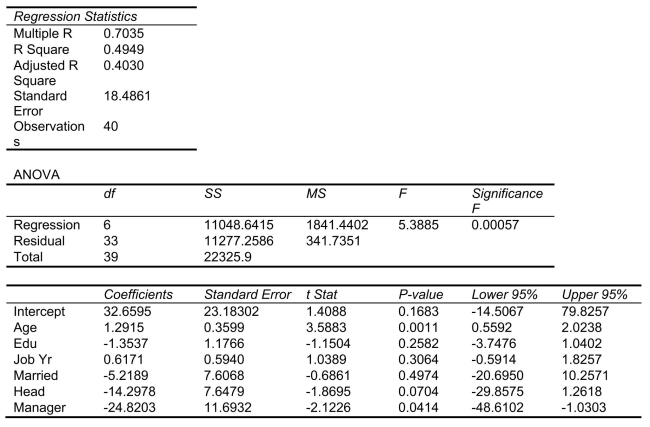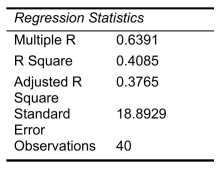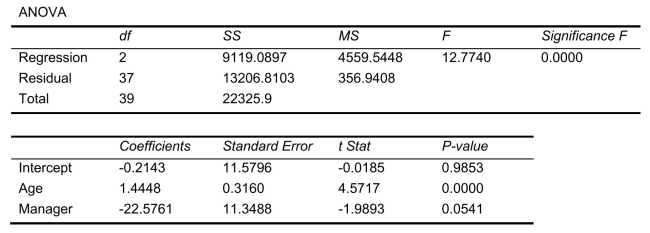SCENARIO 18-10 Given below are results from the regression analysis where the dependent variable is the number of weeks a worker is unemployed due to a layoff (Unemploy)and the independent variables are the age of the worker (Age), the number of years of education received (Edu), the number of years at the previous job (Job Yr), a dummy variable for marital status (Married: 1 = married, 0 = otherwise), a dummy variable for head of household (Head: 1 = yes, 0 = no)and a dummy variable for management position (Manager: 1 = yes, 0 = no).We shall call this Model 1.The coefficient of partial determination  of each of the 6 predictors are, respectively, 0.2807, 0.0386, 0.0317, 0.0141, 0.0958, and 0.1201.
of each of the 6 predictors are, respectively, 0.2807, 0.0386, 0.0317, 0.0141, 0.0958, and 0.1201.  Model 2 is the regression analysis where the dependent variable is Unemploy and the independent variables are Age and Manager.The results of the regression analysis are given below:
Model 2 is the regression analysis where the dependent variable is Unemploy and the independent variables are Age and Manager.The results of the regression analysis are given below: 

-Referring to Scenario 18-10 Model 1, we can conclude that, holding constant the effect of the other independent variables, there is a difference in the mean number of weeks a worker is unemployed due to a layoff between a worker who is married and one who is not at a 10% level of significance if we use only the information of the 95% confidence interval estimate for 
Definitions:
Safety Needs
According to Maslow's hierarchy of needs, these are basic requirements for security and protection, following physiological needs in priority.
Neurotic Adults
Individuals exhibiting chronic patterns of self-doubt, anxiety, and unrealistic expectations of perfection.
Case Study
An in-depth analysis of a particular individual, group, event, or situation over a period of time.
Experimental Method
A research method involving the manipulation of variables to establish cause-and-effect relationships, typically within a controlled environment.
Q3: Referring to Scenario 17-6, how many hidden
Q7: Classification tree is not sensitive to the
Q52: Referring to Scenario 20-2, the return to
Q59: Which of the following is NOT among
Q87: Referring to Scenario 17-6, what is the
Q133: Referring to Scenario 19-7, an R chart
Q141: Poke-Yoke devices is among the tools of
Q144: A buyer for a manufacturing plant suspects
Q152: Referring to Scenario 16-9, if one decides
Q199: Referring to Scenario 18-10 and using both